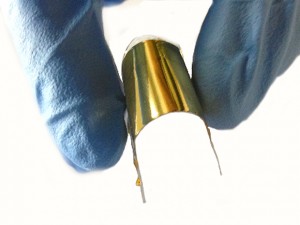

The National University of Singapore has been working towards a new method of generating power in a flexible nanogenerator device that attaches to human skin, using it as a source of static electricity. This electricity turns into electrical energy, which may just be enough to power a small device, like a wearable perhaps (Extreme Tech). Just the size of a postage stamp, it works by tapping into mechanical stress, from hand movements to writhing. The device's electrode, a thin rubber sheet bound to gold film, is held from the skin by tiny pillars, creates friction, then induces electrical currents (Gizmodo). Currents mean voltage, and voltage means powering is possible.
All that make sense? Last week, the University's group presented the idea at the 2015 IEEE MEMS conference, successfully demoing how much electricity this device can actually create. One patch, attached to a subject's forearm and the other to their throat, generated between 7.3 an 7.5 volts, respectively; while finger attachment did a lot better, producing 90 volts (Engadget)! Looks like the new finger bling may be the winner here, because 90 volts is enough to light up 12 commercial LEDs. After these findings, the team is hard at work to make more flexible options that can work with more body parts. They have to hurry, though, because natural energy generation is hot right now (pun, intended). Anyone hear of the tattoo that converts sweat into electricity?

 Laptop & Tablet Parts
Laptop & Tablet Parts




















